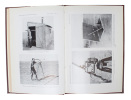"GODDARD, ROBERT H.
Liquid-Propellant Rocket Development (with 11 plates). - [THE WORLD'S FIRST LIQUID-FUELED ROCKET]
Washington, The Smithsonian Institution, 1936. 8vo. In recent red full cloth with gilt lettering to front board. Published as part of ""Smithsonian Miscellaneous Collections, Volume 95, Number 3, Publication 3381"". A fine and clean copy. (2), 10 pp. + 11 photographic plates.
Reference : 54391
First edition of Goddard's paper on liquid-fueled rocket development. Goddard is credited with creating and building the world's first liquid-fueled rocket and is often referred to as the man who ushered in the Space Age (Pendray, Rocket Development). By temperament and training Goddard was not a team worker, yet he laid the foundation from which team workers could launch men to the moon"" (DSB). Goddard was secretive about his research and only published two papers"" ""A Method of Reaching Extreme Altitudes"" (1919) and the present. Goddard launched the first liquid-fuel rocket on 16 March 1926 near Auburn, Mass. The ten-foot rocket, nicknamed ""Nell"" reached an altitude of 41 feet, traveled a distance of 184 feet and landed 2.5 seconds after lift-off in a cabbage patch. ""Although his list of firsts in rocketry was distuguished, Goddard was eventually surpassed by teams of rocket research and development experts elsewhere, particularly in Germany."" (DSB).""Like the Russian hero Konstantin Tsiolkovsky and the German pioneer Hermann Oberth, Goddard worked out the theory of rocket propulsion independently [...] Having explored the mathematical practicality of rocketry since 1906 and the experimental workability of reaction engines in laboratory vacuum tests since 1912, Goddard began to accumulate ideas for probing beyond the Earth's stratosphere. His first two patents in 1914, for a liquid-fuel gun rocket and a multistage step rocket, let to some modest recognition and financial support from the Smithsonian Institution [...] With an eye toward patentability of demonstrated systems and with the aid of no more than a handful of technicians, Goddard achieved a series of workable liquid-fuel flights starting in 1926. Through the patronage of Charles A. Lindbergh, the Daniel and Florence Guggenheim Foundation, and the Carnegie and Smithsonian institutions, the Goddards and their small staff were able to move near Roswell, New Mexico. There, during most of the 1930s, Goddard demonstrated, despite many failures in his systematic static and flight tests, progressively more sophisticated experimental boosters and payloads, reaching speeds of 700 miles per hour and altitudes above 8000 feet in several test flights"" (DSB).
Bookseller's contact details
Herman H. J. Lynge & Son
William Schneider
Silkegade 11
1113 Copenhagen
Denmark
+45 33 155 335
Payment mode
Sale conditions
All items may be returned for a full refund for any reason within 14 days of receipt.
1 book(s) with the same title
Liquid-Propellant Rocket Development (with 11 plates). - [THE WORLD'S FIRST LIQUID-FUELED ROCKET]
Washington, The Smithsonian Institution, 1936. 8vo. In recent red full cloth with gilt lettering to front board. Published as part of ""Smithsonian Miscellaneous Collections, Volume 95, Number 3, Publication 3381"". A fine and clean copy. (2), 10 pp. + 11 photographic plates.
First edition of Goddard's paper on liquid-fueled rocket development. Goddard is credited with creating and building the world's first liquid-fueled rocket and is often referred to as the man who ushered in the Space Age (Pendray, Rocket Development). By temperament and training Goddard was not a team worker, yet he laid the foundation from which team workers could launch men to the moon"" (DSB). Goddard was secretive about his research and only published two papers"" ""A Method of Reaching Extreme Altitudes"" (1919) and the present. Goddard launched the first liquid-fuel rocket on 16 March 1926 near Auburn, Mass. The ten-foot rocket, nicknamed ""Nell"" reached an altitude of 41 feet, traveled a distance of 184 feet and landed 2.5 seconds after lift-off in a cabbage patch. ""Although his list of firsts in rocketry was distuguished, Goddard was eventually surpassed by teams of rocket research and development experts elsewhere, particularly in Germany."" (DSB).""Like the Russian hero Konstantin Tsiolkovsky and the German pioneer Hermann Oberth, Goddard worked out the theory of rocket propulsion independently [...] Having explored the mathematical practicality of rocketry since 1906 and the experimental workability of reaction engines in laboratory vacuum tests since 1912, Goddard began to accumulate ideas for probing beyond the Earth's stratosphere. His first two patents in 1914, for a liquid-fuel gun rocket and a multistage step rocket, let to some modest recognition and financial support from the Smithsonian Institution [...] With an eye toward patentability of demonstrated systems and with the aid of no more than a handful of technicians, Goddard achieved a series of workable liquid-fuel flights starting in 1926. Through the patronage of Charles A. Lindbergh, the Daniel and Florence Guggenheim Foundation, and the Carnegie and Smithsonian institutions, the Goddards and their small staff were able to move near Roswell, New Mexico. There, during most of the 1930s, Goddard demonstrated, despite many failures in his systematic static and flight tests, progressively more sophisticated experimental boosters and payloads, reaching speeds of 700 miles per hour and altitudes above 8000 feet in several test flights"" (DSB).
 Write to the booksellers
Write to the booksellers




